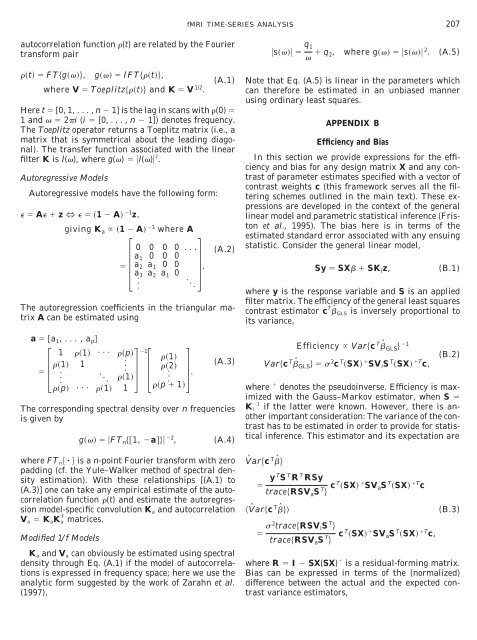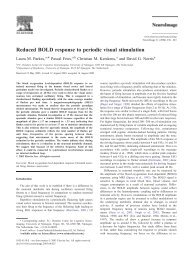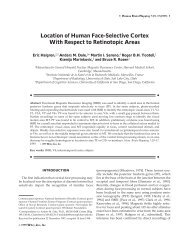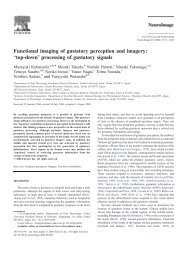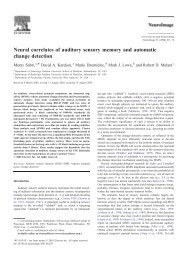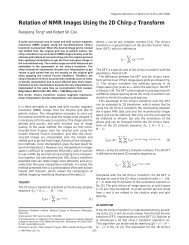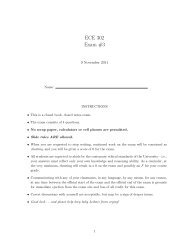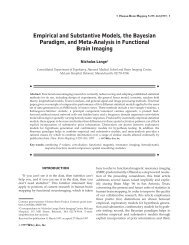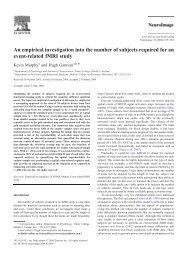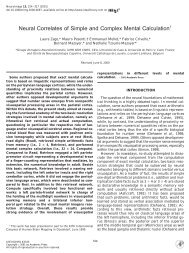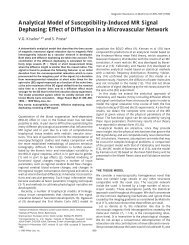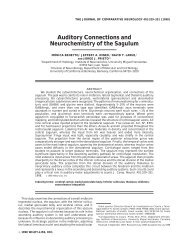Bias and Efficiency in fMRI Time-Series Analysis - Purdue University
Bias and Efficiency in fMRI Time-Series Analysis - Purdue University
Bias and Efficiency in fMRI Time-Series Analysis - Purdue University
Create successful ePaper yourself
Turn your PDF publications into a flip-book with our unique Google optimized e-Paper software.
<strong>fMRI</strong> TIME-SERIES ANALYSIS<br />
207<br />
autocorrelation function (t) are related by the Fourier<br />
transform pair<br />
t FTg, g IFTt,<br />
where V Toeplitzt <strong>and</strong> K V 1/2 .<br />
(A.1)<br />
Here t [0,1,...,n 1] is the lag <strong>in</strong> scans with (0) <br />
1 <strong>and</strong> 2i (i [0,...,n 1]) denotes frequency.<br />
The Toeplitz operator returns a Toeplitz matrix (i.e., a<br />
matrix that is symmetrical about the lead<strong>in</strong>g diagonal).<br />
The transfer function associated with the l<strong>in</strong>ear<br />
filter K is l(), where g() l() 2 .<br />
Autoregressive Models<br />
Autoregressive models have the follow<strong>in</strong>g form:<br />
A z N 1 A 1 z,<br />
giv<strong>in</strong>g K a 1 A 1 where A<br />
<br />
0 0 0 0 . . .<br />
a 1 0 0 0<br />
a 2 a 1 0 0<br />
a 3 a 2 a 1 0<br />
· ·<br />
···<br />
·.<br />
(A.2)<br />
The autoregression coefficients <strong>in</strong> the triangular matrix<br />
A can be estimated us<strong>in</strong>g<br />
a a 1 ,...,a p <br />
<br />
1 1 ··· p<br />
1 1<br />
·<br />
···<br />
· 1<br />
···<br />
·<br />
p ··· 1 1<br />
1<br />
1<br />
2<br />
p<br />
···<br />
1.<br />
(A.3)<br />
The correspond<strong>in</strong>g spectral density over n frequencies<br />
is given by<br />
g FT n 1, a 2 ,<br />
(A.4)<br />
where FT n { }isan-po<strong>in</strong>t Fourier transform with zero<br />
padd<strong>in</strong>g (cf. the Yule–Walker method of spectral density<br />
estimation). With these relationships [(A.1) to<br />
(A.3)] one can take any empirical estimate of the autocorrelation<br />
function (t) <strong>and</strong> estimate the autoregression<br />
model-specific convolution K a <strong>and</strong> autocorrelation<br />
V a K a K a T matrices.<br />
Modified 1/f Models<br />
K a <strong>and</strong> V a can obviously be estimated us<strong>in</strong>g spectral<br />
density through Eq. (A.1) if the model of autocorrelations<br />
is expressed <strong>in</strong> frequency space; here we use the<br />
analytic form suggested by the work of Zarahn et al.<br />
(1997),<br />
s q 1<br />
q 2, where g s 2 . (A.5)<br />
Note that Eq. (A.5) is l<strong>in</strong>ear <strong>in</strong> the parameters which<br />
can therefore be estimated <strong>in</strong> an unbiased manner<br />
us<strong>in</strong>g ord<strong>in</strong>ary least squares.<br />
APPENDIX B<br />
<strong>Efficiency</strong> <strong>and</strong> <strong>Bias</strong><br />
In this section we provide expressions for the efficiency<br />
<strong>and</strong> bias for any design matrix X <strong>and</strong> any contrast<br />
of parameter estimates specified with a vector of<br />
contrast weights c (this framework serves all the filter<strong>in</strong>g<br />
schemes outl<strong>in</strong>ed <strong>in</strong> the ma<strong>in</strong> text). These expressions<br />
are developed <strong>in</strong> the context of the general<br />
l<strong>in</strong>ear model <strong>and</strong> parametric statistical <strong>in</strong>ference (Friston<br />
et al., 1995). The bias here is <strong>in</strong> terms of the<br />
estimated st<strong>and</strong>ard error associated with any ensu<strong>in</strong>g<br />
statistic. Consider the general l<strong>in</strong>ear model,<br />
Sy SX SK i z,<br />
(B.1)<br />
where y is the response variable <strong>and</strong> S is an applied<br />
filter matrix. The efficiency of the general least squares<br />
contrast estimator c T ˆ GLS is <strong>in</strong>versely proportional to<br />
its variance,<br />
<strong>Efficiency</strong> Varc T ˆ GLS 1<br />
Varc T ˆ GLS 2 c T SX SV i S T SX T c,<br />
(B.2)<br />
where denotes the pseudo<strong>in</strong>verse. <strong>Efficiency</strong> is maximized<br />
with the Gauss–Markov estimator, when S <br />
K 1<br />
i if the latter were known. However, there is another<br />
important consideration: The variance of the contrast<br />
has to be estimated <strong>in</strong> order to provide for statistical<br />
<strong>in</strong>ference. This estimator <strong>and</strong> its expectation are<br />
Vˆ arc T ˆ <br />
<br />
y T S T R T RSy<br />
traceRSV a S T c T SX SV a S T SX T c<br />
Vˆ arc T ˆ <br />
2 traceRSV i S T <br />
traceRSV a S T <br />
c T SX SV a S T SX T c,<br />
(B.3)<br />
where R I SX(SX) is a residual-form<strong>in</strong>g matrix.<br />
<strong>Bias</strong> can be expressed <strong>in</strong> terms of the (normalized)<br />
difference between the actual <strong>and</strong> the expected contrast<br />
variance estimators,


